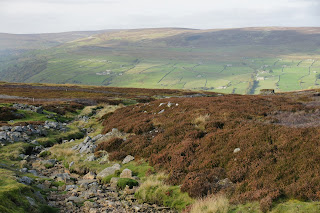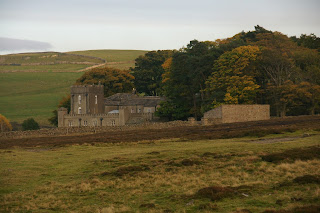What do I put all that kit in?
It is always important to carry some essential items with you when you are out hiking. I carry different things for summer and spring/autumn/winter - the latter three are cooler and the days are shorter. Of course, that means I can sometimes get caught out, like I did the other day on Great Shunner Fell, due to not thinking about the change in season - that could have been disastrous, as I was totally unprepared for the possibility of spending the night on the fell. I had assumed I would be back at the car well before the sun set - and we all know what they say about it when you assume anything: it makes an ass out of u and me!
So I thought writing a blog post about essential kit would be helpful, first to remind myself what I ought to have with me and, second, to help anyone else who might be thinking of taking a day hike and not knowing what to take with them.
Does carrying all that kit make the rucksack heavy? Well, yes, but not unwieldy. I would rather have kit I didn't use than not have kit I needed in an emergency. The worry would have been relieved immensely on Great Shunner Fell had I had a simple additional item - a torch! But there would have been no panic at all if I had carried my usual autumn/winter kit. This is going to take more than one post (five in all) to cover all the kit adequately, without giving you too much to read and scroll through in one go):
what to carry it all in;
clothing essentials;
the kit inside the pack/pockets;
food supplies;
first aid kit)
First of all, a rucksack is obviously essential to carry it all in, but not just any rucksack - it needs to be well fitting and small enough not to be a burden while at the same time being big enough to carry the kit. Like with shoes, people are different sizes and rucksacks are not really a 'one size fits all' item. A good supply store should have people who are experienced in making sure the rucksack fits properly, so try a few and just ask.
I carry an Alpine Aqua 35+5, which is available from Blacks. It is grey with bright yellow straps. At first, I thought the straps were a bit too bright - more like a fashion statement than a hiking pack - but then again, if I were to get lost in fog, they actually stand out like a fluorescent jacket.
The main body of the pack is 35 litres; it has a top pack 'lid' which measures 5 litres. I'm not sure why they measure in litres, because really, you aren't going to fill them with water to carry around - well, not on purpose anyway. I suppose it is just that they are difficult to measure, as these days they are shaped to allow the air to circulate around your back, so you don't get too hot and therefore damp with perspiration. The physical measurements however are:
17.5" tall (minus the 'lid' part)
11"wide (when the side pockets are empty)
8" deep, front to back, measured at the base of the pack
The lid adds another 4.5" to the height at the back, seen here as the part standing above the shoulder straps:
In any event, it is large enough for all my needs when out on a day hike (I have a much larger pack for if/when I have planned to stay out overnight - the important word being 'planned').
It closes using a system I hadn't come across before and while it is fiddly, once you get used to it, it isn't a problem. Each compartment (the main body and the lid), has a bag-like bit sticking out of the top. This ends in a hard/firm strip on either side of the opening. The strips are held together and the bag part is rolled up (directions for which way to roll are printed on the pack), then the ends, which have a buckle on, are closed into the other half of the buckle on the outside of the pack. This has the advantage of making doubly sure that the contents remain dry should it rain heavily while you are out. I probably haven't explained that very well, so here is a series of photos showing the process:
There are two side pockets and a front pocket too. The front pocket will take a map and not much else;
the side pockets are each quite big enough to take a 1 litre water bottle comfortably.
On the outside, there are two mesh pockets. I don't tend to use these, as I don't have anything I need to get at quickly that isn't already in my jacket pockets. I suppose I could put my water bottle or walking poles in them (the poles would also need to be tied in with the straps or they will just fall out), which would free up a side pocket for something else, like hats, gloves or food supplies.
The shoulder straps are padded and are adjustable.
The waistband is also padded on the hips.
This was an essential requirement when I was looking to replace my previous rucksack. The weight of the pack should sit on your hips. If the hip strap is not padded, then it can chafe or dig in and be very uncomfortable. The waistband needs to be tight enough to allow the pack to sit firmly on the hips, so the hips take the weight. Otherwise, the weight is hanging off your shoulders and that only leads to back aches, sore shoulders and a crick in the neck! I have lost some weight recently and had failed to re-adjust the waist straps when I went up Great Shunner Fell. By the time I reached the top, my shoulders were aching considerably. Adjusting the waist strap soon solved that problem. I do however need to adjust it again, as from now on I will be carrying a greater weight, which can also make the pack drag on your shoulders.
Another nice feature is that there are molle type straps on the front, so if I wanted to attach a secondary pack, or a separate first aid kit, I could do so easily. There is also an elasticated strap zigzagged up the front of the pack, which might be a better place for the hiking poles, or a camera tripod, if you are a keen photographer. You could probably fit your roll mat vertically up there too.
At the bottom of the bag is another zipped pocket, in which the rucksack's waterproof cover is neatly stowed. In theory, it is possible to access this while the pack is still on your back and, with a bit of a wiggle, get the rain cover over the pack without ever taking the rucksack off. However, this is something I have yet to master! As a bonus, the cover is actually attached to the bag, so it can't blow away if it's windy and you can't lose it or leave it home accidentally.
For most light showers, the pack is waterproof enough, but persistent drizzle or a heavier shower, or indeed a downpour, and you would need the cover. All the zips are covered by flaps, so light rain should not penetrate and seep through the fabric zip edges.
Finally, there is a chest strap, which prevents the shoulder straps from falling sideways and pulling on your shoulders. The buckle is made of bright orange plastic and has a whistle on it. I haven't used the whistle yet, so I have no idea how loud it is.
The only thing it seems to lack are D rings for attaching things externally (like a camp mug for instance) using a karabiner, but as it is for day use only, it is not really necessary. In any case, there are several loops made of webbing that could be very useful instead of D rings.
Next post: Clothing Essentials




























































